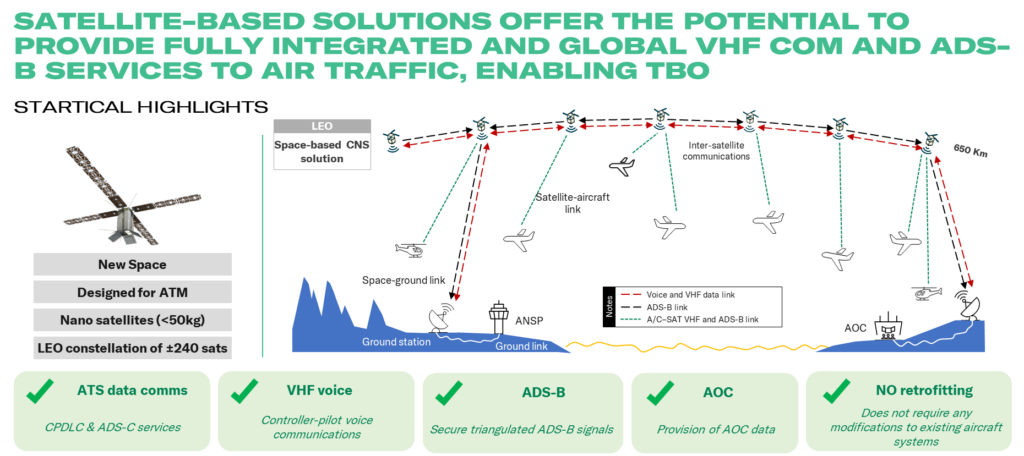Connecting the Skies: Space-Based VHF communications for enhanced air traffic control
Space-Based Very High Frequency (VHF) communications is an innovative concept that provides communications between aircraft and Air Traffic Control (ATC) via satellite radio links to be operated in the aeronautical mobile-satellite (route) service (AMS(R)S).
This concept holds exceptional significance for flight operations in regions with limited connectivity, especially across oceanic and remote areas. It complements and enhances existing aviation navigation and surveillance technologies, such as Automatic Dependent Surveillance (ADS).
Existing long-range communication technologies, like High Frequency (HF) and conventional satellite links, may not deliver the necessary performance for achieving aircraft-to-aircraft proximity comparable to terrestrial VHF communications. Consequently, satellite-based technology addresses these limitations, particularly in oceanic and remote regions where deploying terrestrial VHF infrastructure is impractical.
The illustration below depicts the space-based VHF communication concept. The space segment both receives and transmits signals to the standard VHF radios already installed on aircraft. This system functions like a VHF tower positioned in the sky, offering larger coverage compared to terrestrial towers.

An important aspect of the space-based VHF concept is that it is based on the use of existing airborne equipment. The system will be able to interact with standard on-board ADS-B and VHF system, catering to both VHF digital data links and voice communications.
The major expected operational benefits of the space-based VHF concept include:
- Harmonised operational procedures for Air Traffic Controllers (ATCOs) in continental and oceanic areas.
- Enhanced safety for aircraft operations in oceanic and remote continental areas.
- Considerable improvement in communication capacity across oceanic and remote regions.
- No additional training required for Air Traffic Controllers, as the operation mirrors aeronautical terrestrial VHF communications.
- No additional avionics are required in aircraft;
- Significant reduction in fuel consumption, leading to fewer CO2 emissions due to the use of optimal and efficient routes
- Increased situational awareness for Air Traffic Controllers with more accurate aircraft position information
Importantly, voice and digital data communications between ATCOs and pilots will remain unchanged. These communications will seamlessly integrate whether using terrestrial or space technology.
It is important to emphasise that voice and digital data communications between ATCOs and pilots will remain unchanged. These communications will be fully transparent to both ATCOs and pilots, eliminating the need for them to differentiate whether the support for their communications comes from terrestrial or space technology.
Civil Aviation Administrations, the aeronautical industry, avionics systems providers, aircraft manufacturers, satellite industries, and operators have collaboratively assessed the feasibility of this new concept and its compatibility with existing systems operating within the same and adjacent frequency bands. From this comprehensive analysis, several conclusions have been drawn:
- Satellite-based voice and datalink services can seamlessly integrate into the existing ground infrastructure using current operational procedures, without needing any modification to current avionics;
- Satellite-based voice and data services have the potential to coexist harmoniously with the current terrestrial aeronautical services;
- Satellite-based voice and digital data services can also coexist with adjacent band services and without any adverse impact to those services.
The concept of space-based VHF communication stands as a bridge to the future and has the potential to effectively support the International Civil Aviation Organization (ICAO) initiative “no country left behind”.
Startical, a joint venture between ENAIRE and Indra, is set to promote a constellation of satellites, specifically tailored for ATM. This constellation will provide satellite-based VHF communications (voice and data) and ADS-B surveillance services.




